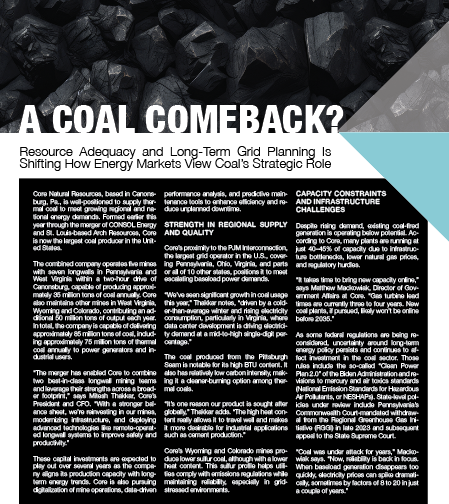Resource Adequacy and Long-Term Grid Planning Is Shifting How Energy Markets View Coal’s Strategic Role
 Core Natural Resources, based in Canonsburg, Pa., is well-positioned to supply thermal coal to meet growing regional and national energy demands. Formed earlier this year through the merger of CONSOL Energy and St. Louis-based Arch Resources, Core is now the largest coal producer in the United States.
Core Natural Resources, based in Canonsburg, Pa., is well-positioned to supply thermal coal to meet growing regional and national energy demands. Formed earlier this year through the merger of CONSOL Energy and St. Louis-based Arch Resources, Core is now the largest coal producer in the United States.
The combined company operates five mines with seven longwalls in Pennsylvania and West Virginia within a two-hour drive of Canonsburg, capable of producing approximately 35 million tons of coal annually. Core also maintains other mines in West Virginia, Wyoming and Colorado, contributing an additional 50 million tons of output each year. In total, the company is capable of delivering approximately 85 million tons of coal, including approximately 75 million tons of thermal coal annually to power generators and industrial users.
“The merger has enabled Core to combine two best-in-class longwall mining teams and leverage their strengths across a broader footprint,” says Mitesh Thakkar, Core’s President and CFO. “With a stronger balance sheet, we’re reinvesting in our mines, modernizing infrastructure, and deploying advanced technologies like remote-operated longwall systems to improve safety and productivity.”
These capital investments are expected to play out over several years as the company aligns its production capacity with long-term energy trends. Core is also pursuing digitalization of mine operations, data-driven performance analysis, and predictive maintenance tools to enhance efficiency and reduce unplanned downtime.
Strength in Regional Supply and Quality
Core’s proximity to the PJM Interconnection, the largest grid operator in the U.S., covering Pennsylvania, Ohio, Virginia, and parts or all of 10 other states, positions it to meet escalating baseload power demands.
 “We’ve seen significant growth in coal usage this year,” Thakkar notes, “driven by a colder-than-average winter and rising electricity consumption, particularly in Virginia, where data center development is driving electricity demand at a mid-to-high single-digit percentage.”
“We’ve seen significant growth in coal usage this year,” Thakkar notes, “driven by a colder-than-average winter and rising electricity consumption, particularly in Virginia, where data center development is driving electricity demand at a mid-to-high single-digit percentage.”
The coal produced from the Pittsburgh Seam is notable for its high BTU content. It also has relatively low carbon intensity, making it a cleaner-burning option among thermal coals.
“It’s one reason our product is sought after globally,” Thakkar adds. “The high heat content really allows it to travel well and makes it more desirable for industrial applications such as cement production.”
Core’s Wyoming and Colorado mines produce lower sulfur coal, although with a lower heat content. This sulfur profile helps utilities comply with emissions regulations while maintaining reliability, especially in grid-stressed environments.
Capacity Constraints and Infrastructure Challenges
Despite rising demand, existing coal-fired generation is operating below potential. According to Core, many plants are running at just 40–45% of capacity due to infrastructure bottlenecks, lower natural gas prices, and regulatory hurdles.
“It takes time to bring new capacity online,” says Matthew Mackowiak, Director of Government Affairs at Core. “Gas turbine lead times are currently three to four years. New coal plants, if pursued, likely won’t be online before 2035.”
As some federal regulations are being reconsidered, uncertainty around long-term energy policy persists and continues to affect investment in the coal sector. Those rules include the so-called “Clean Power Plan 2.0” of the Biden Administration and revisions to mercury and air toxics standards (National Emission Standards for Hazardous Air Pollutants, or NESHAPs). State-level policies under review include Pennsylvania’s Commonwealth Court-mandated withdrawal from the Regional Greenhouse Gas Initiative (RGGI) in late 2023 and subsequent appeal to the State Supreme Court.
“Coal was under attack for years,” Mackowiak says. “Now, reliability is back in focus. When baseload generation disappears too quickly, electricity prices can spike dramatically, sometimes by factors of 8 to 20 in just a couple of years.”
This renewed attention on resource adequacy and long-term grid planning is shifting how energy markets view coal’s strategic role.
Coal Reserves and Investment Conditions
Core’s mines contain 2 billion tons of thermal coal reserves, with several operations having more than two decades of remaining life. But developing new mines, or expanding existing ones, hinges on longer-term market signals.
“Until a new coal plant is committed and financed, it’s hard to justify opening a new thermal coal mine,” Thakkar explains. “The reserves are there. The demand is growing. But capital investment requires long-term certainty.”
As power markets continue to evolve, companies like Core will play a critical role in balancing energy independence, infrastructure investment, and reliability requirements across the region.